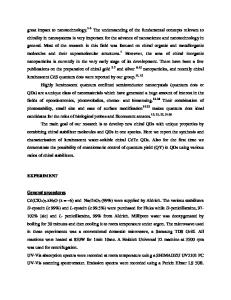Quantum Dots as Inorganic DNA-Binding Proteins
- PDF / 291,565 Bytes
- 4 Pages / 414.72 x 648 pts Page_size
- 81 Downloads / 363 Views
[4].
In the present study we have examined aspects of our system that are more reminiscent of a biological system; we have made H2 NCH 2 CH 2 S-capped CdS particles as more "protein-like" surfaces, and have adsorbed DNAs of different sequences. EXPERIMENTAL Materials. Anhydrous Na2S (Alfa), NaOH (Mallinckrodt), sodium polyphosphate (Aldrich) and Cd(N0 3)2 .4H 20 (Baker) were used as received. All reagents for buffers and electrophoresis were 597 Mat. Res. Soc. Symp. Proc. Vol. 452 01997 Materials Research Society
of the highest purity available. Reverse-phase chromatographic resin (Vydac C 18) was obtained from Aldrich. Oligonucleotides were synthesized by standard phosphoramidite chemistry in the USC Institute for Biological Research and Technology's Oligonucleotide Synthesis Facility: 5'-GTGTGTGTGTGTGTGTGTGTGTG-3' and complement as a "straight" duplex; 5'-AAAAAGGGCCCAAAAAAGGGCCC-3' and complement as a "bent" duplex. All oligonucleotides were purified by high pressure liquid chromatography (HPLC) on a Beckman System Gold HPLC instrument with a reverse-phase column and a triethylammonium acetate/acetonitrile gradient. Deionized and purified water (Continental Water Systems) was used in all experiments. Instrumentation. Electronic absorption spectra were collected with a Perkin Elmer Lambda 14 UVvisible spectrophotometer. Steady-state luminescence spectra were acquired with a SLM-Aminco 8100 spectrofluorometer, with excitation at 350 nm and 4 nm resolution. Transmission electron microscopy (TEM) was performed on a Hitachi H-8000 electron microscope; samples were prepared by placing a drop of the solution onto a nitrocellulose-copper grid and drying overnight at room temperature. Synthesis of 2-mercaptoethylamine-capped CdS. CdS particles were prepared by a modification of a literature preparation [5], with reagent weights based on a final concentration of 2x10- 4 M. Cd(N0 3 )2 "4H2 0 (39 RtL of a 0.0798 g/mL solution in water) and (NaPO3)6 (72 gxL of a 0.0851g/mL solution in water) were added to 50 mL H20 degassed with N2 , and the pH was adjusted to 8.3 with 1.0 M NaOH. Na 2 S (301.tL of a 0.027g/mL aqueous solution) was then added with vigorous stirring. 2-mercapto-ethylamine (2.6 gQ) was then added and stirring was continued for 15 min. The pH was adjusted to 10.5, yielding a colorless solution which glowed yellow under UV light. Excess Cd 2 + (50 RxL of a 0.0798 g/mL solution) was added and the pH was again adjusted to 10.5 Particle sizing was done by TEM. Calculation of particle size from the UV-vis absorption spectrum according to the method of Brus [6] agreed well with the results from TEM (47 ± 10 A diameter). Luminescence Titrations. In a typical procedure, 5 tL aliquots of approximately millimolar (nucleotide) DNA solutions (5 mM phosphate buffer, pH 7.2) were added every 30 minutes to 200 ýiL of a 2 x 10-4 M colloidal CdS solution. The luminescence intensity was integrated over the wavelength range of 480-800 nm and corrected for buffer effects. The photoluminescence of the CdS solution alone was not f
Data Loading...








